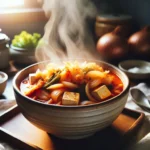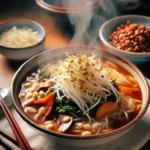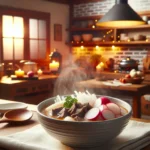Imagine a steaming bowl of nourishing Korean beef seaweed soup, also known as Soegogi Miyeokguk, wrapping you in warmth on a chilly day. This traditional dish, rich in flavor and texture, has the power to make any meal feel like a comforting hug. From its tender beef to the vibrant seaweed, every ingredient harmonizes in a delightful symphony for your taste buds. If you’ve ever wanted to bring a taste of Korea into your kitchen, you’re in the right place. Let’s embark on a culinary adventure that elevates the ordinary into the extraordinary! Discover the art of making this exquisite soup and unlock the secrets to enhancing its flavors.

Ingredients You’ll Need for the Perfect Soup
Creating the perfect Soegogi Miyeokguk, or Korean beef seaweed soup, begins with a careful selection of ingredients that not only bring richness in flavor but also provide the quintessential essence of this beloved dish. Get ready to gather an exciting array of elements that will transform your kitchen into an aromatic haven! 🌿🥢
Beef Selection
First and foremost, high-quality beef is a must! Opt for around 200-300 grams (about 7-10 oz) of beef brisket or short ribs. These cuts provide the tender texture that will elevate your soup! As for the beef, cutting it into bite-sized pieces is recommended for quicker cooking and for the perfect bite! Yum! 🍖✨
Star Ingredient
Next up, you can’t forget about the star ingredient: seaweed, or “miyeok.” 30-50 grams of dried miyeok (about 1-2 oz) should suffice. This sea vegetable not only delivers a delightful, chewy texture to the soup but it also packs a punch of vitamins and minerals! After soaking it in water for about 30 minutes, it will expand and become lush and savory—an incredible transformation that adds depth to your dish! 💧🌊
Seasonings
Now, let’s talk seasonings! You’ll need a tablespoon of sesame oil, which lends a wonderful nutty flavor! Also, don’t skimp on the garlic; around 3-4 cloves minced will do the trick! Plus, two tablespoons of soy sauce will help achieve that umami kick! And if you fancy a bit of spice, consider adding a pinch (or more, if you’re bold!) of black pepper for an extra zing! 🌶️🥳
Liquid Base
For liquid, typically around 1.5 to 2 liters (about 6 to 8 cups) of water is ideal. However, if you’re seeking greater depth, feel free to substitute some of the water with beef broth—just think of the layers of flavor that will bring! Stocked up already? Good!
Onion Addition
And let’s not overlook onions! Adding one medium-sized onion chopped will enhance the overall flavor profile exceptionally well, coaxing out sweetness as it simmers.
Garnish
Finally, for garnish, a sprinkle of chopped green onions (scallions) will add brightness and color to your finished dish. A handful should be just right. 🎉🥬
You see, gathering these quality ingredients sets the stage for a heartwarming bowl of Korean beef seaweed soup that warms both the body and soul. Being mindful of each component enhances the experience and brings out the best in this traditional creation. Who knew such deliciousness could come from thoughtful simplicity? Get ready to embark on a flavor adventure! 🍲💖
Step-by-Step Cooking Instructions
To create a delightful bowl of Soegogi Miyeokguk (Korean Beef Seaweed Soup), follow these carefully crafted steps that will guide you through the entire cooking process. 🌊✨
1. Soak the Seaweed
Begin with a generous amount of dried miyeok (seaweed). Typically, about 30 grams (or approximately 1 cup) is perfect for a 4-serving recipe. Immerse it in cold water for at least 30 minutes to allow the seaweed to rehydrate and expand, transforming into those luscious strands that are the perfect vessel for flavor! 🧜♀️
2. Prepare the Beef
While the seaweed is soaking, take 200 grams of beef (preferably brisket or flanken-cut) and slice it into thin strips—around 1/4 inch thick. This ensures tender bites that soak up the soup’s essence beautifully. If you want to enhance the richness, you can use bone-in beef! 🔪
3. Sauté the Ingredients
Heat a tablespoon of sesame oil in a large pot over medium heat. Once the oil is shimmering, toss in the sliced beef! Sauté it for about 3-4 minutes until it starts to brown slightly, releasing that delicious aroma. To elevate the flavor, add 2 cloves of minced garlic and a sprinkle of salt during this step. The magic begins here! 🥢
4. Add the Seaweed
Now that the beef is sizzling with flavor, drain the soaked seaweed and add it to the pot. Stir everything well, allowing the seaweed to mingle with the beef and absorb those savory notes for about 5 minutes. The colors of the ingredients begin to dance together, creating a vibrant sight! 🌈
5. Pour the Broth
Time to unleash that nourishing broth! Gradually pour in 6 cups of water (or beef broth for an even deeper flavor) into the pot. Bring the mixture to a gentle boil, then reduce the heat to low for a simmer. Allow the soup to simmer for at least 20-30 minutes, letting all those wonderful flavors meld together. The seaweed will become tender, and the beef will fall apart beautifully. It’s like a warm hug in a bowl! 🥣❤️
6. Season to Perfection
As the soup transforms, season it well! Add 2-3 tablespoons of soy sauce, a teaspoon of salt (adjust to taste), and a touch of pepper. Don’t hesitate to sample it along the way—this is your masterpiece! Some might choose to add a pinch of red pepper flakes for a subtle kick! Just enough to get those taste buds tingling! 🌶️👅
7. Finalize with Sesame Oil
To finish, drizzle in an additional teaspoon of sesame oil for that final touch of richness. Stir it gently and let it rest for a few moments. This step really elevates the flavor profile, adding a toasted, nutty depth that’s simply irresistible! ✨🍜
8. Serve
Once the soup is at the perfect temperature, remove it from the heat. Ladle the Soegogi Miyeokguk into bowls and garnish with finely chopped scallions if desired. The vibrant color contrasts and tantalizing aroma beckon you to dive in! 🍽️
Whether enjoyed on a chilly day or served as a part of a feast, this hearty soup delights each tastebud, with its umami richness and comforting warmth! 📅✨ Wishing you a joyous cooking experience!
Tips for Enhancing Flavor and Texture
Achieving the perfect balance of flavor and texture in your Korean Beef Seaweed Soup (Soegogi Miyeokguk) is a crucial part of the culinary experience. An ideal bowl is not just about the taste; it’s a dance of savory, rich, and refreshing notes, coupled with a delightful texture that makes each spoonful a joy! 🥣✨
1. Choose Quality Ingredients
First and foremost, the quality of the ingredients significantly impacts the end product. Select premium cuts of beef, preferably brisket or chuck, for a richer flavor profile. Look for seaweed that has a dark, glossy appearance, which indicates freshness. Did you know that using Korean miyeok (seaweed) provides essential nutrients like iodine and calcium? This not only elevates the dish in terms of health factors but also deepens the overall flavor complexity! 🌊🍖
2. Soak the Seaweed Right
For the best texture, soak the dried seaweed in cold water for at least 30 minutes. This process isn’t just about rehydration; it also allows the seaweed to absorb some natural sweetness from the water! After soaking, squeeze out excess water to prevent your soup from becoming too slimy. A well-prepared seaweed adds a delightful chewiness that brings the soup to life! 🌱💧
3. Perfecting the Broth
The broth is where you can really shine with your seasoning! Many producers of premium beef broths utilize methods like simmering bones for hours to extract maximum flavor (up to 12 hours!). For home cooks, consider simmering your beef with aromatics like garlic, ginger, and a splash of soy sauce for at least an hour. This not only enriches the broth but infuses your beef with flavors that permeate every bite! 🧄🧅
4. Time it Right
Adding the seaweed towards the end of cooking is a gold nugget tip! If you add it too early, it can become overly soft and lose that invigorating texture. Just 10 minutes before serving is ideal—this timing will allow the seaweed to absorb the savory broth while maintaining a perfect tender crunch. ⏲️🔥
5. Adjust Seasoning
Tasting is believing! Feel free to adjust the seasoning as you go. A tablespoon of sesame oil can lend a nutty depth, while a pinch of salt enhances the natural essence of the ingredients. A splash of fish sauce or a hint of gochugaru (Korean red pepper flakes) can add a subtle kick that makes the soup pop! Each of these ingredients adds another layer of flavor, creating that crave-worthy bowl! 🌶️🥜
6. Garnish Wisely
Don’t underestimate the power of a well-placed garnish! Thinly sliced green onions bring a fresh contrast to the rich broth, while a sprinkle of sesame seeds adds both a delicate crunch and a hint of nuttiness. Consider adding a few drops of sesame oil on top just before serving; this simple step can turn your already fantastic soup into an unforgettable experience! 🌿🌟
7. Serve with Care
Presentation matters! Serve the soup hot and in a shallow bowl to showcase the vibrant colors and textures. Accompanying dishes such as rice or kimchi can bring balance to the meal. The contrast of warm soup with textured sides like crunchy pickles or creamy rice can elevate your overall dining experience. 🎉🍚
By combining these tips, you can elevate your Korean Beef Seaweed Soup to a gourmet dish that rivals your favorite restaurant! Each element—from preparation to presentation—ensures a bowl full of warmth, flavor, and happiness, inviting everyone to gather around and share in the joy of a well-made meal. Wouldn’t you love to impress your friends and family with an unforgettable culinary masterpiece? 🌈🍽️
Serving Suggestions and Variations
When it comes to serving Soegogi Miyeokguk, the focus should be on elevating the dish to create a delightful experience for you and your guests! 💖 This versatile soup can stand alone as a refreshing meal but can also be transformed into a magnificent feast when paired wisely. Here are some creative serving suggestions and exciting variations that will surely captivate taste buds!
Garnishing and Presentation
To start, consider serving the beef seaweed soup in individual bowls, garnished with a sprinkle of sesame seeds for an added crunch and a touch of elegance! 🥢✨ A thin drizzle of sesame oil will also enhance the rich flavors. This elevates presentation while ensuring everyone enjoys a visually appealing bowl that’s brimming with nutrients.
Protein Additions
Now, let’s spice things up! Have you ever tried adding other proteins? Shrimp is a fantastic addition. Just toss in peeled, deveined shrimp during the last few minutes of cooking. This technique ensures your shrimp stays tender and infuses a delightful seafood flavor into the broth. 🍤💦 For those feeling adventurous, try incorporating a splash of gochujang (Korean chili paste) to introduce a mild heat! This slight twist can add depth without overwhelming the intrinsic essence of the soup.
Pairing Suggestions
Pairing this hearty soup with sides can amplify the overall meal. Think about serving it alongside a bowl of fluffy steamed rice to soak up all that savory goodness! 🍚 Alternatively, feasting on a medley of banchan (Korean side dishes) provides a delightful contrast to the soup. Kimchi, seasoned cucumbers, or a spicy radish salad offer contrasting textures and flavors that enhance the dining experience. This combination not only satisfies but also embodies a harmonious balance of nutrients—perfect for anyone aiming for a health-conscious dish.
Creative Variations
For those who love culinary experimentation, consider variations! You might develop a spicy miso version with the creamy richness of miso paste. Blend it into broth for a unique umami punch. Alternatively, create a vegetarian version by substituting the beef with mushrooms like shiitake or portobello, and using vegetable broth instead of beef! 🌱🙌 Health-conscious individuals might enjoy using konjac noodles for a low-carb option, turning this traditional soup into a trendy favorite that’s still wallet-friendly and satisfying.
Seasonal Serving Ideas
And don’t forget to consider the season as a key element in serving suggestions! During colder months, serving your Miyeokguk piping hot with a side of Korean pancakes (jeon) is a comforting way to ward off the chill! Your guests will appreciate the warm, fulfilling meal that encourages coziness and togetherness. 🍂❄️
Embracing Seasonal Variations
Seasonal variations can also be delightful! During spring, incorporate fresh vegetables like bok choy or asparagus into the soup to brighten the flavor and texture. These ingredients not only add color but also provide additional vitamins and minerals, making it a deliciously nutritious dish suitable year-round! 🌸🥦
In conclusion, Soegogi Miyeokguk can adapt to a variety of preferences and occasions, flexibly transforming a simple recipe into a gourmet experience! Whether you choose to stay traditional or venture out with unique twists, this soup always delivers satisfaction and joy. By centering meals around thoughtful combinations and variations, you create memorable moments that linger well beyond the last spoonful! 🎉🍲
As you pour the final touches of seasoning into your Korean Beef Seaweed Soup, take a moment to appreciate the vibrant colors and enticing aromas wafting through your kitchen. This isn’t just a dish; it’s a heartwarming experience steeped in tradition. Each spoonful brings you closer to the rich tapestry of Korean culinary heritage. Remember, the beauty of this soup lies in its adaptability—play with ingredients and spice levels to make it uniquely yours. So gather around the table, share stories, and create lasting memories with every bowl served. Let your culinary journey unfold, embracing flavors that connect us all, transcending time and space.













